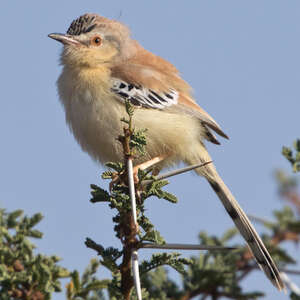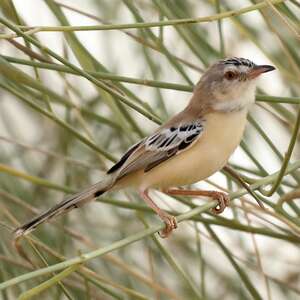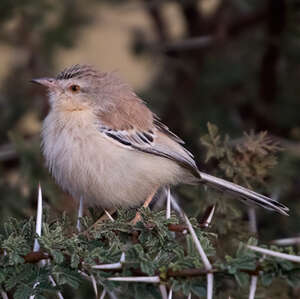Cricket Warbler
Spiloptila clamans - Prinia à front écailleux Spiloptile à front écailleux
Identification
At first glance, the Cricket Warbler appears as a pale warbler with a long tail. The upper part of the body, from the head to the tail, is a light brownish color with a pinkish hue. The greater coverts and alula, blackish and edged with white or cream, contrast sharply with the rest of the top. The remiges are dark brown but the beige or rosy brown edging largely hides this brown, which can however be better distinguished at the level of the tertiaries. The rectrices are brownish in color with a dark subterminal band and a pale end. The underside is cream and more or less tinged with red brown.
The sexes are distinguished by their heads. For the male, it is light gray with a cap striped with black and white and highlighted by a whitish eyebrow. The lores are pale and the cheeks tinged with reddish. The female has a light chamois head, with a distinctly less marked cap and reddish cheeks. The rather long and thick beak is slightly curved. It is pink, with black and white extremities. The eye color is honey or light brown and surrounded by a pinkish or reddish orbital circle. The legs are pink.
Subspecific information monotypic species
Foreign names
- Prinia à front écailleux,
- Prinia charlatana,
- prínia-do-sael,
- Schuppenkopfsänger,
- tücsökprínia,
- Krekelprinia,
- Beccamoschino vocifero,
- sahelsångare,
- Sirissanger,
- penička pustatinná,
- prinie cvrčkohlasá,
- Sahel-sanger,
- sahelinkerttu,
- prínia cridanera,
- Krybbusöngvari,
- sahelka,
- circeņu ķauķis,
- čričkar,
- Чешуйчатая приния,
- コオロギムシクイ,
- 蟋蟀鹪莺,
- sahelsångare,
- 喬木長尾鷦鶯,
Voice song and call
The song consists of a prolonged and monotonous repetition of the same note, which can be translated as hip hip hip hip hip.... The tone of the song and the frequency of the notes emitted are variable (usually 2 to 4 syllables per second). Often it becomes almost a trill and resembles the sound of an insect. It is emitted from the interior of a woody plant, never in the open. The calls are varied and usually of the same tone and form a kind of babble, serving to cohere the couple or group. The alarm call would be a sharp zrt.
Habitat
This is a typically Sahelian species. It occupies semi-arid to arid acacia savannas on sandy or gravelly ground.
Behaviour character trait
The Cricket Warbler lives in pairs or small family groups throughout the seasons. The bird is not really shy and does not try to hide, but finding it in its habitat is not always easy.
It thoroughly explores the bushes and low vegetation, hopping quickly from one to another. It also frequently descends to the ground between clumps, flicking its long tail, and it is in these conditions that one has the best chances of observing it well. It sometimes perches out in the open at the top of a small bush or tuft of grass, although very briefly. Fortunately, it is vocal and it is usually located by its voice. The male's song attracts attention, but one must know it because one would rather attribute it to an insect.Flight
Dietfeeding habits
The diet is insectivorous. She searches for insects in vegetation or on the ground. She takes advantage of opportunities such as the flowering of nectar-bearing plants that attract pollinators. I have seen her hunting around the flowers of Capparis decidua at the start of the dry season. She also hunts large insects such as orthopterans, mantids, ...
Reproduction nesting
The breeding season varies depending on locality and weather conditions. It is synchronized with the optimal development of vegetation and entomofauna.
The species is monogamous. The couples are territorial, and the males defend their territory with singing.The nest is built less than 2 meters high in a bush or dense herbaceous clump. It is a deep cup made of herbs and other plant materials, lined with fine elements (vegetal hair and feathers) and protected by a roof. The female lays (2) 3 to 4 (5) eggs. Other parameters of the breeding of the Cricket Warbler are not known.
Geographic range
The Cricket Warbler is distributed in a rather narrow, continuous sub-Saharan belt extending from the Atlantic Ocean (Mauritania and Senegal) to the Red Sea (Eritrea). Population islands exist north of this area, for example in South Morocco (Saharaoui), northern Mauritania and northern Sudan. It is resident.
Threats - protection
Sources of information
- IOC World Bird List (v15.1), Gill, F and D Donsker (Eds). 2025-12-07.
- Birds of Africa South of the Sahara, Ian Sinclair and Peter Ryan
- Avibase, Lepage Denis
- HBW Alive,
- xeno-canto, Sharing bird sounds from around the world,
Other sources of interest
 Specification sheet created on
28/07/2023 by Jean François
Specification sheet created on
28/07/2023 by Jean FrançoisTranslation by AI Oiseaux.net
© 1996-2026 Oiseaux.net
- Accipitriformes
- Aegotheliformes
- Anseriformes
- Apodiformes
- Apterygiformes
- Bucerotiformes
- Caprimulgiformes
- Cariamiformes
- Casuariiformes
- Charadriiformes
- Ciconiiformes
- Coliiformes
- Columbiformes
- Coraciiformes
- Cuculiformes
- Eurypygiformes
- Falconiformes
- Galliformes
- Gaviiformes
- Gruiformes
- Leptosomiformes
- Mesitornithiformes
- Musophagiformes
- Nyctibiiformes
- Opisthocomiformes
- Otidiformes
- Passeriformes
- Pelecaniformes
- Phaethontiformes
- Phoenicopteriformes
- Piciformes
- Podargiformes
- Podicipediformes
- Procellariiformes
- Psittaciformes
- Pterocliformes
- Rheiformes
- Sphenisciformes
- Steatornithiformes
- Strigiformes
- Struthioniformes
- Suliformes
- Tinamiformes
- Trogoniformes




























